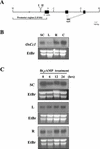High-level and ubiquitous expression of the rice cytochrome c gene OsCc1 and its promoter activity in transgenic plants provides a useful promoter for transgenesis of monocots
- PMID: 12177461
- PMCID: PMC166736
- DOI: 10.1104/pp.002261
High-level and ubiquitous expression of the rice cytochrome c gene OsCc1 and its promoter activity in transgenic plants provides a useful promoter for transgenesis of monocots
Abstract
Expression patterns of a rice (Oryza sativa) cytochrome c gene OsCc1 and its promoter activity were characterized in transgenic rice plants. OsCc1 transcripts accumulate in most cell types, but to varying levels. Large amounts of OsCc1 transcripts are found in the roots, calli, and suspension cells, but relatively lower in mature leaves, demonstrating its higher levels of expression in non-photosynthetic tissues. Unlike the human cytochrome c gene, which is responsive to cAMP, OsCc1 expression is not enhanced in various rice tissues after dibutyryl cAMP treatments. OsCc1 promoter was linked to the sgfp gene and its activities in different tissues and cell types of transgenic rice plants were analyzed in comparison with the Act1 and RbcS promoters. OsCc1 promoter directs expression in virtually all organs of transgenic plants including roots, leaves, calli, embryos, and suspension cells, showing a particularly high activity in calli and roots. Activity of the OsCc1 promoter was 3-fold higher than Act1 in calli and roots and comparable with RbcS in leaves, representing a useful alternative to the maize (Zea mays) Ubi1 and the rice Act1 promoters for transgene expression in monocots.
Figures






Similar articles
-
[Specific expression of the foreign gene regulated by the rice rbcS promoter in transgenic rice].Zhi Wu Sheng Li Yu Fen Zi Sheng Wu Xue Xue Bao. 2005 Jun;31(3):247-53. Zhi Wu Sheng Li Yu Fen Zi Sheng Wu Xue Xue Bao. 2005. PMID: 15961898 Chinese.
-
OsBLE3, a brassinolide-enhanced gene, is involved in the growth of rice.Phytochemistry. 2006 Jul;67(14):1442-54. doi: 10.1016/j.phytochem.2006.05.026. Epub 2006 Jun 30. Phytochemistry. 2006. PMID: 16808934
-
The LP2 leucine-rich repeat receptor kinase gene promoter directs organ-specific, light-responsive expression in transgenic rice.Plant Biotechnol J. 2009 Dec;7(9):867-82. doi: 10.1111/j.1467-7652.2009.00449.x. Epub 2009 Sep 28. Plant Biotechnol J. 2009. PMID: 19781006
-
Inducible overexpression of a rice allene oxide synthase gene increases the endogenous jasmonic acid level, PR gene expression, and host resistance to fungal infection.Mol Plant Microbe Interact. 2006 Oct;19(10):1127-37. doi: 10.1094/MPMI-19-1127. Mol Plant Microbe Interact. 2006. PMID: 17022177
-
Arabidopsis mutants by activation tagging in which photosynthesis genes are expressed in dedifferentiated calli.Plant Cell Physiol. 2006 Mar;47(3):319-31. doi: 10.1093/pcp/pci242. Plant Cell Physiol. 2006. PMID: 16597626
Cited by
-
Abiotic stress responsive rice ASR1 and ASR3 exhibit different tissue-dependent sugar and hormone-sensitivities.Mol Cells. 2013 May;35(5):421-35. doi: 10.1007/s10059-013-0036-7. Epub 2013 Apr 24. Mol Cells. 2013. PMID: 23620302 Free PMC article.
-
The Rice GLYCINE-RICH PROTEIN 3 Confers Drought Tolerance by Regulating mRNA Stability of ROS Scavenging-Related Genes.Rice (N Y). 2021 Mar 19;14(1):31. doi: 10.1186/s12284-021-00473-0. Rice (N Y). 2021. PMID: 33742286 Free PMC article.
-
Analysis of the Wsi18, a stress-inducible promoter that is active in the whole grain of transgenic rice.Transgenic Res. 2011 Feb;20(1):153-63. doi: 10.1007/s11248-010-9400-y. Epub 2010 May 20. Transgenic Res. 2011. PMID: 20490919
-
Isolation and functional characterization of a novel rice constitutive promoter.Plant Cell Rep. 2014 Oct;33(10):1651-60. doi: 10.1007/s00299-014-1644-1. Epub 2014 Jul 1. Plant Cell Rep. 2014. PMID: 24980160
-
The activities of four constitutively expressed promoters in single-copy transgenic rice plants for two homozygous generations.Planta. 2015 Jun;241(6):1529-41. doi: 10.1007/s00425-015-2278-4. Epub 2015 Mar 26. Planta. 2015. PMID: 25809149
References
-
- Battraw MJ, Hall TC. Histochemical analysis of CaMV 35S promoter-β-glucuronidase gene expression in transgenic rice plants. Plant Mol Biol. 1990;15:527–538. - PubMed
-
- Chiu W-L, Niwa Y, Zeng W, Hirano T, Kobayashi H, Sheen J. Engineered GFP as a vital reporter in plants. Curr Biol. 1996;6:325–330. - PubMed
-
- Christensen AH, Quail PH. Ubiquitin promoter-based vectors for high-level expression of selectable and/or screenable marker genes in monocotyledonous plants. Transgenic Res. 1996;5:213–218. - PubMed
-
- Christensen AH, Sharrock RA, Quail PH. Maize polyubiquitin gene: structure, thermal perturbation of expression and transcript splicing, and promoter activity following transfer to protoplasts by electroporation. Plant Mol Biol. 1992;18:675–689. - PubMed
Publication types
MeSH terms
Substances
Associated data
- Actions
LinkOut - more resources
Full Text Sources
Other Literature Sources

